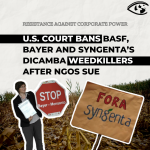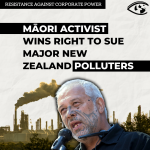A First Class Ozone Destroyer
Scientists Comment on the Impact of Delaying the Phaseout of Methyl Bromide
Statements from policy and press briefings organized by Ozone Action and held in Washington, DC on February 14, 1996.
Arjun Makhijani, Ph.D.
President of the Institute for Energy and Environmental Research
I have been asked to comment on a possible delay of the U.S. ban on methyl bromide set for 2001 under the Clean Air Act. During the next decade, ozone depletion will be at its most severe due to significant chlorine and bromine loading of the stratosphere. Ozone depletion has been consistently worse than estimated by models. Depletion has not occurred predictably, but suddenly after chlorine concentrations cross certain thresholds.
Policymakers should be wary of making policies that would add any additional ozone depleting chemicals to the atmosphere. The atmosphere works on the model of, the straw that broke the camels back. We do not know what the next threshold of sudden ozone depletion worsening may be. The most important challenges are to keep the peak of chlorine as low and of as short a duration as possible and to bring equivalent chlorine and bromine levels back below the 2.4 parts per billion threshold as early as possible to minimize adverse health and environmental effects (it is currently over 4 ppbv). Because methyl bromide has a short atmospheric lifetime, the impact of banning the chemical early will have disproportionately beneficial effects. Delaying a ban on methyl bromide extends the period during which we remain above the 2.4 ppbv threshold, with unpredictable ozone depletion and the consequences of UV-B radiation.
Additionally, weakening the U.S. ban to match the slower production phase-out recently adopted by the developed nations in Vienna would forfeit U.S. leadership on an issue where the U.S. has exerted critical
leadership in the past. The U.S. also bears the greatest responsibility for banning methyl bromide because it is the largest user. Furthermore, any delay or exemptions would remove the strong incentive to industry to find alternatives to methyl bromide by 2001. It is useful to remember a similar deregulatory era that began in late 1980. At the time, President Reagan promised to roll back many regulations. Analysis of the record indicates that CFC producers responded by reducing or eliminating their already small research budgets into CFC alternatives. It was not until 1986 when the Montreal Protocol was imminent that
the companies began again in earnest to seek CFC alternatives. The lost opportunity in the intervening years did considerable damage to the ozone layer and made the costs of finding alternatives much greater. It would be unwise to repeat these same mistakes today.
F. C. De Fabo, Ph.D.
Resident Professor of Dermatology, The George Washington University Medical Center
...It is important to recognize the efforts of the policy making arm of the global community in protecting the ozone layer. It is true that efforts to rectify ozone depletion are in effect (Montreal Protocol, London and Copenhagen Amendments) and , indeed, these are very welcomed decisions. As a result, the growth of some major chlorine containing compounds into the stratosphere has slowed significantly and will gradually decline. But is it enough?
Stratospheric chlorine concentration are currently so high it is predicted that it will take decades to
return to 1985 levels. Some model estimates suggest present ozone-dependent changes may last another 40-50 years. Of course, as with all model calculations and estimates, uncertainties in their predictions exist and "surprises" often occur. usually, however, these surprises turn out to be more on the negative rather than the positive side. For example, none of the early models predicted an Antarctic ozone hole nor the magnitude of the depletion recorded.
In view of the above, it is my opinion that for full recovery of the stratospheric ozone layer to occur it will be necessary that:
all countries comply completely with the Montreal Protocol and its amendments,
all CFC replacements are ozone-safe and not just "friendly,"
curbs are enforced on bromine containing compounds such as halons 111211, 111301, and the global ban on methyl bromide put into effect by 2001 as recommended by the recent Scientific Assessment on Ozone
Depletion: 1994 report (NOAA, NASA, UNEP, WMO: Report #37), andno "atmospheric chock" such as major volcanic eruptions occur to insert particles into the stratosphere which increase the loss of ozone such as occurred with the recent Pinatubo eruptions.
Lastly, the possibility exists that other, as yet unknown, factors may alter model predictions of future
ozone trends.
Given these considerations, a compelling argument can be made that the impacts of present and future
enhancements in UV-B radiation may well be felt for decades to come. More, not less, stringent requirements on ozone destroying chemicals are needed to curb ozone depletion. More, not less, support (non-financial as well as monetary) is needed for a coordinated federal program on the effects of UV-B radiation on
living systems. These actions are crucial if we expect to have the answers we need provided to us on this daunting, long-term environmental problem.
- 181 Food and Agriculture



